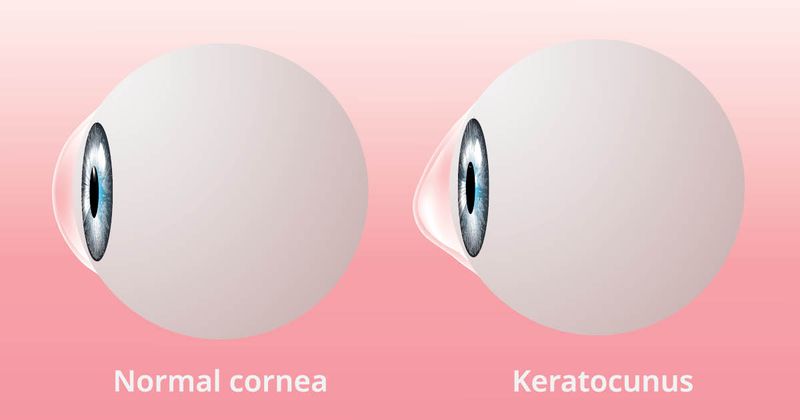What is your preferred choice for visual rehabilitation in patients with keratoconus?
Click here to read the Cover Story, "Consistent positive trends in refractive surgery revamp motivation to innovation."
Allograft inlays a natural way to reshape the cornea
My personal strategy for visual rehabilitation in patients with keratoconus is a wonderful sterile allograft inlay, the KeraNatural, developed by the Lions VisionGift eye bank in the U.S.

Source: Adobe Stock.
I like to call the procedure “collagen injection.” Much as we use collagen to refill and correct imperfections in our skin, we can use it to reshape irregular corneas. It is an equally easy and fast procedure that takes only 5 or 6 minutes. We create channels in the cornea with the femtosecond laser and inject the collagen rings into them. And like aesthetic surgeons who call you after a few weeks to check whether the procedure needs fine-tuning, we call our patients to check and perform some custom adjustments. We can easily split, reduce, shorten, add or remove collagen tissue to tailor the effect and enhance our results.
We have now 2 years of follow-up in 120 eyes. No patient had vision loss, and 30% had an increase in vision of six lines or more. Usually, to further stabilize the cornea and halt disease progression, I perform cross-linking after 6 months. However, several patients have come to me for vision improvement with a previously cross-linked cornea, and I performed the collagen injection on them. It works both ways, before or after CXL.

These rings were originally designed for presbyopia. I tried them, they worked well, and I thought: Why not use them for keratoconus? I suggested some shape changes, which the company made, and so we have now this wonderful option.
Patients with keratoconus are young and until recently had only keratoplasty as an option, a long, invasive surgery under general anesthesia with uncertain outcomes and a high rate of failure in the long term. My mission is to make keratoplasty a thing of the past for patients with keratoconus because keratoplasty is no longer necessary for them. We have now a procedure that is minimally invasive, quick to perform under topical anesthesia, adjustable and reversible, and it does not preclude corneal transplantation in the few cases in which it might be needed at a later stage.
Aylin Kiliç, MD, is an associate professor with Medipol University Hospital, Istanbul, Turkey.
Each case should be approached individually
Implantation of intracorneal ring segments (ICRS) is my preferred approach for visual rehabilitation of patients with ectatic corneal diseases.

Besides being a customizable, adjustable and reversible procedure, the femtosecond laser enhances its safety and predictability. ICRS options evolved from standard rings with constant thickness to the more recent Keraring AS (Mediphacos) with progressive thickness, and I am also optimistic about implanting corneal tissue, such as corneal allogenic intrastromal ring segments.
However, I believe that rather than have a preference, we should approach each case individually based on the patient’s needs and characteristics of multimodal refractive imaging.
By the end of the last century, penetrating keratoplasty was essentially the only surgical option when glasses and contact lenses were not successful. Later on, cross-linking, ICRS, customized therapeutic surface photoablation (PRK) and phakic IOLs emerged as options to treat patients with ectasia before keratoplasty. This paradigm shift led to paradoxes considering the hows and whys in managing patients with keratoconus and ectatic corneal diseases. The paradox is related to the indications for surgery and the therapeutical goals as opposed to elective refractive surgery. When needed for therapeutic purposes, surgery should be performed as soon as possible. Conversely, it should be carefully considered if the fundamental indications of preventing ectasia progression and vision rehabilitation are absent. For example, CXL is effective for halting ectasia progression and should be promptly performed when there is documented ectasia progression or if there is consistent evidence of its possibility (high susceptibility). Nevertheless, the indication for CXL in mild cases should be concerned about its risks as opposed to the quest not to miss the opportunity to prevent vision loss.
Vision rehabilitation should also obey a hierarchy of needs, considering nonsurgical options such as glasses and contact lenses. Elective custom surface ablation (PRK) is controversial but can be performed according to established safety parameters with no prophylactic CXL. The combination of photoablation with CXL can be considered before or after ICRS, as proposed in the Athens protocol (PTK plus custom topo-guided PRK) and its Cretan and Tel-Aviv variations.
Patient education, as in the Violet June Campaign, is fundamental for conscious decisions, considering the set of available options.
Renato Ambrosio Jr., MD, PhD, is an adjunct professor with the Federal University of the State of Rio de Janeiro, Brazil, and president of the International Society of Refractive Surgery.
